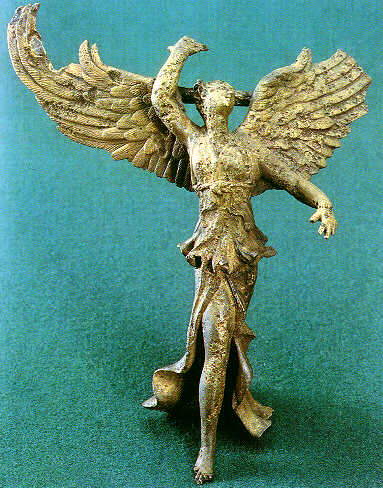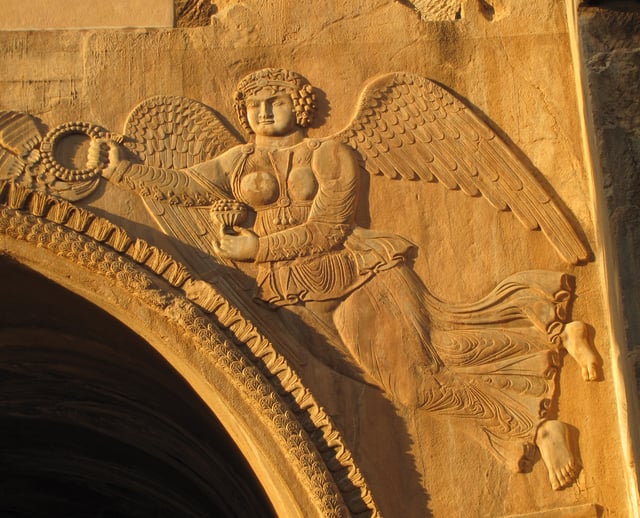Nike (mythology)
-XqaFpuLaCbqOKm3nwnCf77U31AN01o)
Nike (mythology)
-XqaFpuLaCbqOKm3nwnCf77U31AN01o)
| Nike | |
|---|---|
Goddess of victory | |
| Abode | Mount Olympus |
| Symbol | golden sandals, wings, wreaths |
| Personal information | |
| Parents | Pallas and Styx |
| Siblings | Kratos, Bia, Zelus |
| Roman equivalent | Victoria |
In ancient Greek religion, Nike (/ˈnaɪki/; Ancient Greek: Νίκη, "Victory" [nǐːkɛː]) was a goddess who personified victory. Her Roman equivalent was Victoria.
| Nike | |
|---|---|
Goddess of victory | |
| Abode | Mount Olympus |
| Symbol | golden sandals, wings, wreaths |
| Personal information | |
| Parents | Pallas and Styx |
| Siblings | Kratos, Bia, Zelus |
| Roman equivalent | Victoria |
Etymology

Statuette of goddess Nike found in Vani, Georgia
Family

Nike in Taq Bostan, Iran
Nike was variously described as the daughter of the Titan Pallas and the goddess Styx, and the sister of Kratos (Strength), Bia (Force), and Zelus (Zeal).[4]
And Styx the daughter of Ocean was joined to Pallas and bore Zelus (Emulation) and trim-ankled Nike (Victory) in the house. Also she brought forth Cratos (Strength) and Bia (Force), wonderful children.
In other sources, Nike was described as the daughter of Ares, the god of war.
Ares ... O defender of Olympos, father of warlike Nike (Victory).
Mythology

Statue of the Goddess Nike on the Titanic Engineers' Memorial, Southampton
Nike and her siblings were close companions of Zeus, the dominant deity of the Greek pantheon. According to classical (later) myth, Styx brought them to Zeus when the god was assembling allies for the Titanomachy against the older deities. Nike assumed the role of the divine charioteer, a role in which she often is portrayed in Classical Greek art. Nike flew around battlefields rewarding the victors with glory and fame, symbolized by a wreath of laurel leaves (bay leaves).
Depiction
Nike is seen with wings in most statues and paintings, with one of the most famous being the Winged Victory of Samothrace. Most other winged deities in the Greek pantheon had shed their wings by Classical times. Nike is the goddess of strength, speed, and victory. Nike was a very close acquaintance of Athena, and is thought to have stood in Athena's outstretched hand in the statue of Athena located in the Parthenon.[5] Nike is also one of the most commonly portrayed figures on Greek coins.[6] After victory at the Battle of Marathon, Athenians erected the Nike of Callimachus.[7]
Names stemming from Nike include among others: Nikolaos, Nicholas, Nicola, Nick, Nicolai, Niccolò, Nikolai, Nicolae, Nils, Klaas, Nicole, Ike, Niki, Nikita, Nikitas, Nika, Nieke, Naike, Niketas, Nikki, Nico, and Veronica.
Contemporary usage
The sports equipment company Nike, Inc. is named after the Greek goddess Nike.[8]
Project Nike, an American anti-aircraft missile system is named after the goddess Nike.[9] []
Since Giuseppe Cassioli's design for the 1928 Summer Olympics, the obverse face of every Olympic medal bears Nike's figure holding a palm frond in her right hand and a winner's laurel crown in her left.[10][11]
The Honda motorcycle company's logo is inspired by the goddess Nike.[12]
Family tree
| |||||||||||||||||||||||||||||||||||||||||||||||||||||||||||||||||||||||||||||||||||||||||||||||||||||||||||||||||||||||||||||||||||||||||||||||||||||||||||||||||||||||||||||||||||||||||||||||||||||||||||||||||||||||||||||||||||||||||||||||||||||||||||||||||||||||||||||||||||||||||||||||||||||||||||||||||||||||||||||||||||||||||||||||||||||||||||||||||||||||||||||||||||||||||||||||||||||||||||||||||||||||||||||||||||||||||||||||||||||||||||||||||||||||||||||||||||||||||||||||||||||||||||||||||||||||||||||||||||||||||||||||||||||||||||||||||||||||||||||||||||||||||||||||||||||||||||||||||||||||||||||||||||||||||||||||||||||||||||||||||||||||||||||||||||||||||||||||||||||||||||||||||||||||||||||||||||||||||||||||
See also
Winged Victory of Samothrace
Altar of Victory
Nike of Paeonius
Victory, 1902 statue in New York City by Augustus Saint-Gaudens The obverse of Saint-Gaudens' 1907 United States Saint-Gaudens double eagle coin is based on his sculpture of Victory
Ángel de la Independencia
